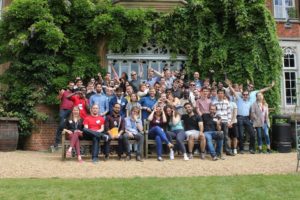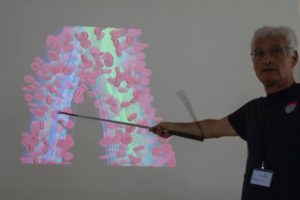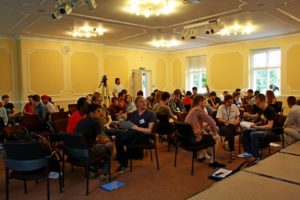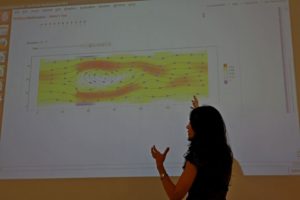
Introduction
Erich Wimmer’s key note talk kick started a summer school on multi-scale materials modelling and science communication. Erich shared an exciting story of his personal journey and work in the field of computational materials science – with experience in academia, industry and even running a company (a co-founder at Materials Design).
A human element shone throughout the talk, emphasising the importance of collaboration and the relationships between colleagues for making the numerous advances in the field possible, and importantly making the process fun and rewarding.
Following the Q&A session informal discussions continued over the dinner in the beautiful dining halls of the Cumberland Lodge. The evening ended with an informal ice-breaking game of treasure hunt, allowing the participants to relax, explore the great Windsor Park and the lodge itself while getting to know each other. Demanding several days awaited – a series of master classes each focusing on time/length scale beyond the familiar grounds for most of the participants; a series of work shops on engaging presentations, communication through infographics and a technical session on data visualization using Mathematica leading to group projects and individual presentations.
Master classes. A rich diversity of physics at different scales
Properties of real materials naturally arise due to an interplay of phenomena on different time and length scales. A series of master classes delivered at Hermes summer school aimed to help participants gain a more holistic understanding of materials. Each master class required active involvement and discussion from the participants, mediated in part by the speaker and in part by group leaders. This approach, common to all Hermes summer schools, allowed to really “digest” the content.
On Thursday morning, Nicola Spaldin had opened the series of master classes. Nicola’s talk focused on her pioneering application of DFT to study the fundamental questions in Physics, paving the way for a unified theory beyond the Standard Model. Following her talk, Nicola challenged the participants to come up with and present an idea for the original use of DFT to address some of the real life problems.
In the following master class Soraia Pimenta had then taken over the stirring wheel from Nicola making a sharp turn into a completely different domain – that of computational mechanics of composite materials. Soraia followed her talk with a hands on exercise focused on a particularly interesting topic in her talk – the size effects on the longitudinal tensile strength of some fibre-reinforced polymers. With guidance, participants built a simple model using Excel or Mathematica to illuminate how the phenomenon stems from the stochastic variability of fibre strength. This format is a welcome first at Hermes, and we hope to see more of it in the future!
Thursday evening was spent in the Cumberland Lodge own cosy pub, in the games room downstairs playing table football and ping pong, or just scattered around the lodge reflecting on all the new information thrown at the participants during the day and simply catching the breath after a really intense day.
On Friday morning Sauro Succi gave a master class on the Lattice Boltzmann method – a tool used to study all sorts of liquids, from blood flow to air turbulence to ice cream bubbles (without artificially building in the bubble partitions by hand!). Sauro’s talk was as educational as it was fun, interspersed with digressions about all and everything.

Friday ended with a classic wine tasting and a poster session.
Finally, Kurt Kramer delivered a master class on polymer physics. Among the principle problems in this subfield is attempting to predict and model protein folding and polymer dynamics in general.
Telling the scientific story
Lulu Piney’s workshop was on the use of infographics and imagery to tell a story. Through multiple examples, the participants learnt how to partition their story in terms of the information to be communicated via infographics and that which is better left as text – linking the two modes of communications effectively

Next, Craig Carter led the all-star MIT team (virtuoso side kicks Kyle Keane, George Varanvides and Emma Vargo) delivering a series of talks with a supervised hands-on session on technical aspects of data visualization using Mathematica. Participants used the skills to then work in a groups to create an interactive data visualization slide to present individually in 5 minutes on one of the master class topics.

The series of communication workshops was concluded with an inspiring, electric performance of a communication trainer and presenter with a truly unique style – Piero Vitelli (Island 41). He taught about the art of an engaging presentation, focusing on the very human emotional and psychological aspects that go into making a presentation unforgettable.
Conclusion
Each of the Hermes organisers is a PhD student who had previously attended the summer school. Continuing in the spirit of Hermes 2012 and Hermes 2014 summer schools, Hermes 2016 provided an enriching experience for all participants once again, carrying forward the main aims and ethos:
- training participants in the theory and simulation of materials beyond the remit of their own PhD field and discipline,
- training in communication – an ability to cast technical scientific content into clear and accessible form using modern media devices and to engage and educate the audience,
- using innovative learning and teaching strategies to ensure a high quality programme with effective knowledge exchange,
- developing a lasting international network of PhD students and academics.
Talks
List of speakers is available on our website, in the online version of the summer school booklet. Slides are not available.
http://hermessummerschool.org/Hermes2016Booklet_Final.pdf
